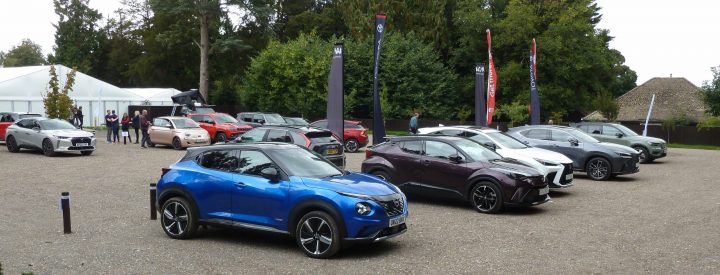The Society of Motor Manufacturers and Traders recently held its annual regional Test Days in the north and south of the country which are always much-liked and useful events on the calendar of many motoring scribes.
An annual event that provides new cars galore on offer for motoring writers to road test in the same locality on the same day, always seems a very good idea to me.
It also gives the opportunity for said writers to meet and chat with public relations representatives from across the motor industry, as well as fellow scribes, to learn more and to exchange notes.
The ‘Test Day South’, based near Basingstoke, was the nearest venue for us and here’s what I thought of them.
Toyota C-HR GR Sport 2.0 Hybrid
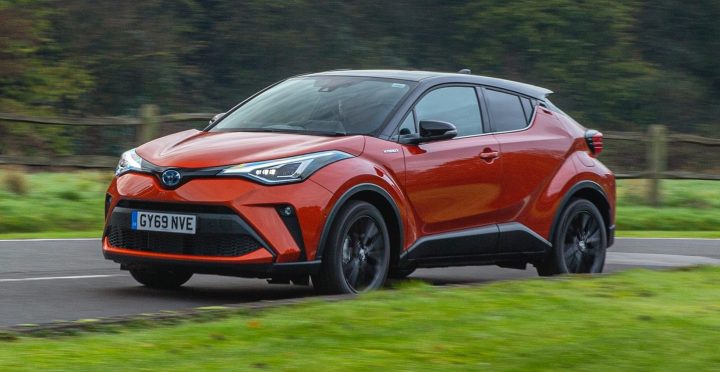
My first drive of the day was in Toyota’s dynamically-styled C-HR compact five door SUV, in GR Sport form. Under its bonnet is a self-charging hybrid set-up, incorporating a two litre, four cylinder petrol engine, working in conjunction with an electric motor, and driving the front wheels through a ‘Continuously Variable Transmission’ – ‘e-CVT’ in Toyota terminology.
Toyota has been selling self-charging hybrid models for many years now, that long experience helping to build confidence and respect as these vehicles have established an enviable reputation in the motor trade and with buyers for solidity, reliability and low running costs.
For many people, a very major advantage of having a self-charging hybrid as opposed to a ‘plug-in electric vehicle’ or PHEV is, of course, that there’s no need for plugging-in the car to a mains electricity supply to re-charge the propulsion battery. The car’s electronic control systems automatically determine the most appropriate delivery of power from the electric motor, the petrol engine, or both (depending on driver requirements), and ensure the recharging of the propulsion battery by the vehicle itself as it is driven. Essentially under deceleration and braking, energy is created and pumped back into the battery.
Hence there is no need to have a home charger set-up installed, or to have the worry of setting up recharging cables etc, necessary with PHEV models. In addition of course there is no so-called ‘range anxiety’ that can be very real and worrying, in the case of pure ‘battery electric vehicles’ of BEVs which have no internal combustion engine at all.
In other words, for many owners a self-charging hybrid is easier to own and live with, although the driving range on electric-only propulsion is more limited than with a PHEV or BEV.
The combined output of my C-HR test car’s petrol/electric power units totals 182 bhp (135 kW), said to enable the car to sprint from rest to 62 mph in 8.2 seconds, and with a potential top speed of 112 mph.
More importantly for many, the Combined fuel consumption under the WLTP protocol is between 49.6 and 54.3 miles per gallon, with CO2 emissions of between 120 and 128 g/km.
From behind the wheel I appreciated the comfort of the Toyota’s seating, and the clarity of the facia design. Importantly, there are easy-to-assimilate displays ahead of the driver, informing him or her of the real-time state of the propulsion systems, and including a brilliantly simple and useful ‘Energy Monitor’ gauge. When there’s enough power in the battery the car can be driven in pure electric mode, or the vehicle itself will decide upon the appropriate mix of petrol and electric power, again depending on available battery power and the demands of the driver at any given moment.
In reality, during my time with the car, when driving on a mixed route of urban traffic, winding, hilly lanes and main roads, the adoption of, and changes between, the electric and petrol power systems took place seamlessly and effortlessly. The car was quiet and smooth when accelerating normally and when cruising at speed; under hard acceleration the petrol engine made itself heard but noise levels were not excessive nor intrusive.
I found that performance was impressive, with eager acceleration when required, from standstill and on the move, but with a welcome docility in urban situations. In short the car was easy and enjoyable to drive in all situations.
I felt that the C-HR provided a firm-ish but controlled ride, with excellent handling and roadholding on the twisting roads that I found.
High rear quarters means that rearward vision was restricted, so the reversing camera set-up is essential, and worked well during my test run.
The car is spacious inside and in terms of luggage accommodation. There is good leg and head room for rear seat occupants, and the boot is wide, deep and fairly long, with a separate multi-tray compartment available beneath the main boot floor, to accommodate smaller items (alongside the emergency tyre inflation kit; there’s no spare wheel).
Equipment levels are high, and in addition to a wide array of safety systems, the test car featured (as examples from a long list) a Toyota Smart Connect+ eight inch HD touch screen, phone connectivity , front and rear parking sensors, etc.
The price of the C-HR was quoted as £35,460, and the test car was equipped with options that included metallic paint (£630 including VAT), Black Alcantara Leaather trim and a JBL Premium Sound System, adding another £1,890 (including VAT). However C-HR models start at £29,330.
VERDICT
Modern, practical, cost-effective to run, enjoyable to drive.
Spec. In Brief:
Toyota C-HR GR Sport 2.0 Hybrid
Power units: 4 cylinder in-line petrol engine, 1987cc, plus electric motor
Combined output:182 bhp/135 kW
Performance:
0 – 62 mph: 8.2 seconds
Top speed: 112 mph
Combined fuel consumption (WLTP): 49.6 to 54.3 mpg
CO2 emissions (WLTP): 120 to 128 g/km
SsangYong Rexton Ultimate 2.2
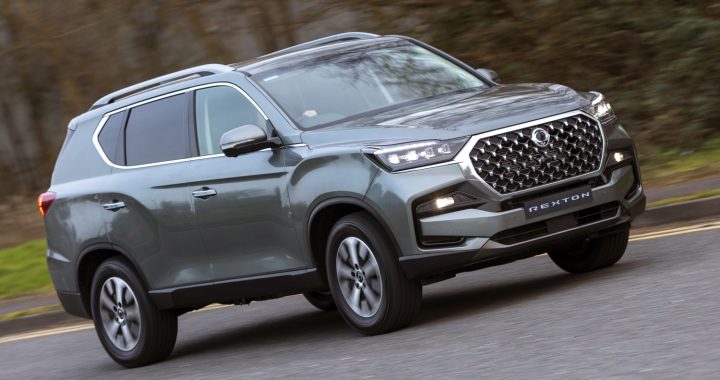
The Korean firm of SsangYong (the name meaning ‘double dragon’) was started in 1954 and in the last few years has been extending its influence in the U.K. market.
As Korea’s only SUV and 4×4 specialist vehicle producer, it has a history of innovation and during the last five years has refreshed its model line-up, with five new models being introduced in that time. These are the Tivoli (small SUV, arriving in in 2015), Rexton (large SUV, 2017), shortbed Musso pick-up (2018), Korando (compact SUV/crossover, 2019) and longbed Musso pick-up (2020). The firm says that more eco-friendly engines and fully electric models are in the pipeline too.
Enhancements to the line-up and successive upgrades through the years have helped to raise the profile of SsangYong vehicles and every time I have driven one over the last decade or so I have been impressed by the improvements.
The first Rexton made its debut in 2001, with development through successive generations since then. Fourth generation models arrived in 2017, and the latest enhancements were brought in during 2020, creating fifth generation Rextons. These benefit from major restyling and upgrading, inside and out, while retaining the practicalities and inherent strengths appreciated by the owners of earlier versions.
These tough, big-hearted Rextons have always been renowned for their strength and versatility, and it is important to note that a ladder frame chassis is the basis around which today’s model is built, which helps to build-in inherent strength.
Today’s Rexton is powered by a 202 PS four cylinder 16 valve 2.2 litre engine, linked to an eight speed Hyundai Transys automatic transmission (the set-up is also used in Kia, Hyundai and Genesis models). In addition to its other attributes, the vehicle is quite capable of towing 3.5 tonnes. Helping it maintain good progress in all conditions, it has a proven full four wheel drive system with switchable high and low ratios available.
Importantly, the engine delivers bags of low speed pulling power (torque), with a maximum of 441 Nm (325 lb.ft) available between 1,600 and 2,600 rpm. This welcome flexibility is helpful during normal motoring and even more of an asset when carrying heavy loads and/or when towing.
I test drove the range-topper Ultimate variant, with an on-the-road price tag of £40,780. Metallic paint costs an additional £690.
The car is packed with state-of-the-art safety and convenience features, with a luxurious interior too – and attention to detail is evident throughout. Notable features of the Ultimate variant include nappa leather upholstery, a nine inch touch screen audio/navigation screen, and a 3D around-vehicle view monitoring system.
I found that the elevated driving position provided a good view of the road, and the driving seat was very comfortable for me. The ‘digital cockpit’ instrumentation was clear and effective too.
An easy-to-use rotary control takes care of two wheel drive/four wheel drive and auto transmission settings, and in every way I found that the Rexton, although large, was straightforward to drive, even in tight spaces.
There are seven seats, with the centre row of three, like the front seats, providing excellent head and leg room, while the rearmost pair of seats looked comfortable, albeit with less space in which to stretch.
With the rear seats folded, available space in the luggage compartment is massive (up to 1,872 litres or 66.11 cu.ft if loaded up to window level), and even with five seats in use there’s generous room for all your gear. The rearmost pair of seats rise from the load floor, obviously then restricting the amount of space for luggage, but there is some room behind these seats.
On the road, I liked the manner in which the 2.2 litre diesel engine produces its pulling power from low down in the rev range, and this aspect, in combination with the eight speed auto gearbox, means that the vehicle always feels as if it is the correct ratio for any given driving situation. Uphill and downdale, fast and slow, in traffic and on the open road, I enjoyed driving the Rexton during my outing in it.
Overall fuel consumption promises to be in the region of 33 mpg, which I feel is pretty good for a large vehicle of its type.
I found that the suspension was quite firm in operation, at least with just me aboard. That’s a characteristic, rather than a criticism, as of course the vehicle is designed for carrying and towing. Overall I rate my experience with the Rexton as ‘comfortable’; I very much liked the accommodating and supportive driver’s seat.
VERDICT
A smart, likeable, effective and very well-equipped large SUV. The Rexton provides interior space galore (for up to seven people), interior sophistication, comfort and strong performance. It also has a huge, flat-floored load compartment and the capacity to tow 3.5 tonnes, with enough pulling power to handle full/heavy loads with ease.
The comprehensive warranty is worth noting too: Seven years/150,000 miles.
The on-the-road price of the vehicle is competitive at £40,780. That is good news indeed, as it needs to be borne in mind that the First Year road tax is a massive £1,420, and £165 per year thereafter.
Spec. in Brief:
SsangYong Rexton Ultimate 2.2
Power units: 4 cylinder 16 valve in-line petrol engine, 2157cc, plus electric motor
Combined output:199.2 bhp
Performance:
0 – 62 mph: 11 seconds
Top speed: 114 mph
Combined fuel consumption (WLTP): 32.85 mpg
CO2 emissions (WLTP): 225 g/km
Suzuki Swift Sport
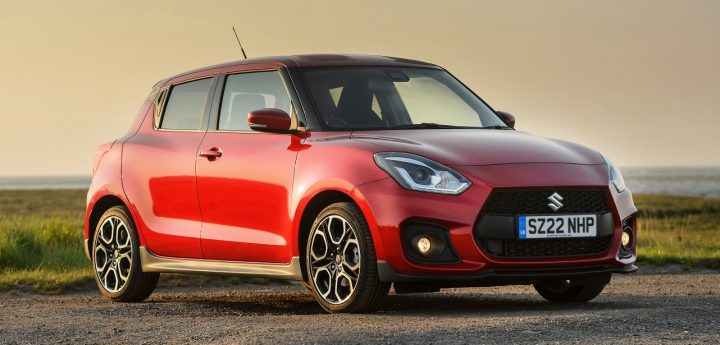
As the end of the Test Day was nearing, I had the chance to re-acquaint myself with Suzuki’s Swift Sport, in its latest self-charging hybrid guise.
I needed no second invitation… Indeed I count myself as being fortunate to be able to drive each successive generation of Swift Sport (the first of which was introduced in 2006), and amazingly they just seem to get better and better.
With the limited time available for my test run, I headed for some open stretches of road known to me in north Hampshire, also taking in some narrow lanes, steep hills and tight bends on the way back to base.
First, the car itself. Powered by Suzuki’s turbocharged 1.4 litre four cylinder Boosterjet engine, and assisted by an enhanced 48 volt ‘mild hybrid’ system – to help minimise emissions and fuel consumption while enhancing performance, the car is a self-charging hybrid. This means that it never needs to be plugged in to recharge the propulsion battery.
It is worth noting that hybrid technology is applied across Suzuki’s range. In addition, unlike its competitors, the company has deliberately kept is model structure straightforward and simple, with items that are often classed as ‘extras’ being built into the already competitive pricing of Suzuki models, including Swift Sport, and indeed all the Swifts.
While not intended to be a ‘very hot’ hatchback, the Swift Sport is nevertheless powerful (129 bhp at 5,500 rpm) and importantly it delivers its maximum torque (pulling power) of 235 Nm or 173 lb.ft at just 2,000 rpm.
Importantly too, while the body shell has a raft of clever safety features built-in, the weight of the car has been kept to just 1,025 kg (2,260 lb), which translates into less effort being required to move it along, in turn meaning that CO2 emissions are low (just 125 g/km) while fuel consumption is excellent, with a Combined WLTP figure of 50.4 miles per gallon.
An important result of the clever technology, weight-wise and in terms of the self-charging hybrid system, is that the car performs effortlessly from all legal speeds, from rest and on the move. For the record, the nought to 62 mph acceleration time is 9.1 seconds, with a potential top speed of 130 mph. However, from behind the wheel the car is inherently sporting in nature. It has an accommodating ride quality, yet handles and holds the road impressively. It responds reassuringly when steering and braking, and when called upon to accelerate, the engine just pulls, and pulls, and pulls. The experience is difficult to describe in words; the term ‘exhilarating’ doesn’t quite cover it, from my perspective. However suffice to say that I still find the Swift Sport one of the most endearing and entertaining compact cars that I have ever driven.
Now in my exuberance and excitement over the driving experience, I should not forget also to mention the practicalities of this car, for it is a full five seater, with four passenger doors plus tailgate, which opens to reveal a usefully large, if not huge, boot, if the rear seats are occupied. With the rear seats folded the luggage compartment grows to become almost small van-like in capacity.
I found the driving seat very comfortable (and I have driven previous versions of the Swift Sport for hundreds of miles on the same day and still felt fresh at the end of the journey; this version promises a similar experience). There’s reasonable head and leg room for rear seat occupants, and generous space for both front seat occupants.
The On-The-Road price of the current Swift Sport is £22,570, which includes a very long list of standard kit, plus £165 for dual-tone metallic paintwork, if chosen.
The First Year road fund tax costs £180, then £165 per annum thereafter.
VERDICT
Yes please.
Spec. in Brief:
Suzuki Swift Sport
Power: 4 cylinder in-line petrol engine, 1373cc, plus 48 volt mild hybrid system
Power:129 bhp @ 5,500 rpm
Torque: 235 Nm (173 lb.ft) @ 2,000 rpm
Performance:
0 – 62 mph: 9.1 seconds
Top speed: 130 mph
Combined fuel consumption (WLTP): 50.4 mpg
CO2 emissions (WLTP): 125 g/km
Ford Mustang Mach-E GT Auto AWD
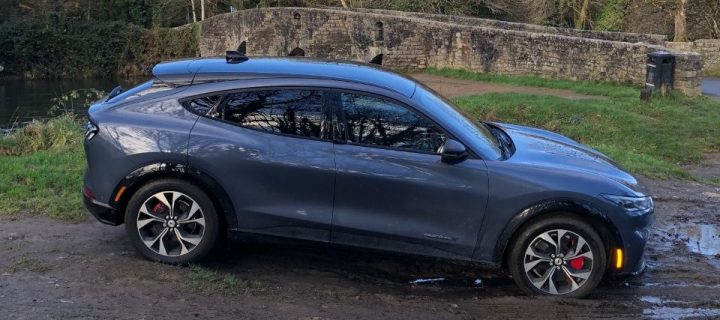
The car transporters were gathering around our test day base venue, ready to collect the test cars, as I ventured out for my last drive of the day, in Ford’s Mustang Mach-E GT fully electric vehicle. Looking terrific in its special ‘Grabber Blue’ paintwork (which costs an additional £1,150 over and above the basic ‘On The Road’ figure of £74,540), this machine features twin electric motors and all wheel drive, to take the car to 62 mph from rest in just 3.7 seconds.
Sadly I was only able to sample the vehicle for 15 minutes or so but in that time I appreciated its excellent performance, good ride comfort and reassuring steering and braking.
I found that the driving seat was comfortable and easily-adjusted to suit my frame, and there was plenty of leg and head room available for rear seat passengers.
I liked the GT Performance seats, but personally wasn’t keen on the very dark black headlining.
The facia is dominated by a very large, deep touch screen (15.5 inch), in addition to the ‘normal’ instrumentation, including a 10.2 inch full digital cluster, ahead of the driver.
On the road, performance proved to be scorching, with handling and roadholding to match. However, the Magneride suspension system did its job unobtrusively, and despite the very large diameter (20 inch) wheels, I didn’t find progress uncomfortable.
Among the many standard-fit features are a front-mounted luggage compartment (in addition to the conventional rear boot, which also has a separate compartment beneath the main floor), a 360 degree camera system, and a B & O Premium Sound System with 10 speakers (including within the dashboard).
An innovative aspect is the external door opening system, operated by a tiny ‘button’ for each door.
VERDICT
Fast, spacious, practical and eye-catching, but certainly not cheap. The long driving range (potentially 310 miles) is a good feature and enables long journeys to be undertaken without fear of running out of power en route…
Spec. in Brief:
Ford Mach-E GT Auto AWD
Power: Electric motor only (pure Battery Electric Vehicle/BEV)
Power:487 PS
Torque:680 Nm (502 lb.ft)
Performance:
0 – 62 mph: 3.7 seconds
Top speed: 124 mph
Combined energy consumption: 20 kwH/100 km
10 to 80 per cent battery charge time: 45 minutes
Driving range (extended): 310 miles
© Words Kim Henson, Wheels-Alive.co.uk,

